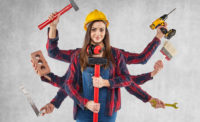I was recently called in to help a company address an issue with dropped objects following two incident reports where workers had dropped a pair of pliers and a spud wrench. When I arrived and explained the reason for my visit, one executive remarked, “Just those two? We’ve had more than 90 drops in the last 90 days!”
With real world numbers like that, it’s incredible that falling objects are not causing more serious injuries or fatalities than records indicate. Contact with objects and equipment — the majority caused by being struck by a falling object — is currently the third-largest cause of death in the workplace, behind transportation incidents and workplace violence. Still, many contractors do not take necessary precautions. It’s so easy to provide protection for both workers and their tools that it’s hard to understand why companies go without them.
Dropped object prevention is important
In a recent incident at a construction site in Jersey City, New Jersey, a truck driver was delivering sheet rock and was killed when a worker 50 stories above dropped a tape measure. The tape measure deflected off something near the ground and hit the driver in the head.
Media coverage focused on the fact the driver wasn’t wearing a hard hat. In reality, people should have asked, “Why was the tape measure allowed to fall?”
Of course no one hearing this story would want to be the driver who died. But we can’t forget about the devastating effects it must have had on the worker who dropped the tape measure, or the rest of the crew.
A dropped object, no matter its size, weight or the height it falls from, is dangerous. To determine what kind of force is generated by an object falling from height, calculations can be done around the physics of gravity. For example, an eight-pound wrench dropped from a height of 200 feet will hit with a force of 2,833 pounds per square inch—the equivalent of a small car hitting a one-square-inch area.
The primary focus should be on fall prevention rather than catching objects that fall or trying to limit the damage they cause after falling. It’s also why fall protection should always — and technically does — refer to anything that can fall. But not all regulations and standards currently reflect this reality, which is why a handful of professionals, myself included, are working with OSHA to create new language that will better protect workers from falling objects.
Changing the conversation
Dropped object prevention hasn’t yet gained the status of worker fall protection because there is a general lack of awareness about how prevalent dropped objects are, how dangerous they can be, and how to effectively prevent them.
Thirty-five years ago, the thought of wearing a seatbelt was absurd to many people. Now most people buckle up without even thinking about it — but this change in behavior didn’t happen overnight. Implementing a drop prevention program for tools will require a similarly significant paradigm shift; one that is challenged by a lack of awareness, a resistance to change, and a drive toward increased productivity.
In the United States, we now expect workers at height to wear a fall protection harness and be tied off because we are trying to prevent people from falling as a basic safety precaution. However, we've done little to prevent tools from falling because we expect that tools will accidentally fall.
Instead, we’ve focused on secondary systems that will catch falling objects such as toe boards or debris nets. We have also relied on PPE to limit the damage a dropped object causes. But as we’ve seen from the unfortunate example of the New Jersey truck driver, secondary systems are not foolproof or always effective. A primary system, like a harness for a person, must also be in place for tools and equipment. Tools are not designed to be used at height. Just like we create an attachment point on a person with a harness, we need to retrofit tools used at height with a harness – an attachment point.
Standards currently in place
OSHA currently requires workers who are in an environment where they are at risk of being hit by something to do the following:
~ Secure tools and materials to prevent them from falling on people below.
~ Barricade hazard areas and post warning signs.
~ Use toe boards, screens on guardrails or scaffolds to prevent falling objects.
~ Use debris nets, catch platforms or canopies to catch or deflect falling objects.
OSHA can use the General Duty clause to cite companies when dropped objects have caused injuries or are a hazard, but it rarely does. Within the next five years it’s likely OSHA will mandate all tools must be tied off. One of the challenges the agency will face is how to create a standard relevant to the thousands of tools used at height on any particular job site. Another challenge: developing testing standards for lanyards, buckets, etc. as they relate to tools, and for standards to be issued surrounding safety labels.
What to do now
Companies need to realize that fall protection means employing equipment needed to keep both workers and tools safe at height. Most organizations have not deployed a drop prevention program for tools and equipment. Expanding a fall protection program to include tools and equipment is a logical approach rather than attempting to create a new program to specifically address drop prevention.
Expanding the definition of “fall protection” has a useful psychological impact as well -- it sends the message that “fall protection is about anything that can fall; not just people.” It’s also important to provide a competent person to manage this expanded program.
Training is an important element to fully integrating a drop prevention program. All employees working at height need to be trained on how to properly install a connection point to the tools they are working with. They also need to understand the equipment available. Many people don’t know there are lanyards and attachments for more than just simple hand tools. Even heavy tools like a 40-pound rivet buster or 80-pound portable generator can and should be secured at height. An on-site training course can teach workers how to safely tie off and secure all their equipment.
Companies should also raise awareness of drop hazards by regularly scheduling “hazard hunts” to help identify hazards and discuss mitigation techniques. And always conduct a risk assessment before work begins where drop hazards may exist.




